 Visualization Practice for Your Recitations of the Six-Syllable Mantra
Visualization Practice for Your Recitations of the Six-Syllable Mantra
When reciting the Six-Syllable Mantra in your routine, first view yourself as Avalokiteshvara holding a pure vase.
Then perceive ten Avalokiteshvaras appearing in the ten directions of east, south, west, north, above, below, and so on. Just like that, the number of Avalokiteshvaras gradually increases until they fill the entirety of space.
Each sentient being has one Avalokiteshvara appearing in front of them holding a pure vase. After that, the nectar water flows from the pure vase, eliminating the sufferings of hell beings in the eight cold and eight hot hells, the sufferings of hungry ghosts with hunger, thirst and the three obstacles, the sufferings of animals eating each other and being in bondage, the sufferings of humans with birth, aging, sickness and death, the sufferings of asuras with fighting, anger and jealousy, and the sufferings of heavenly beings with the five signs of decay.
May the nectar from Avalokiteshvara’s pure vase eliminate all kinds of sufferings of sentient beings in the three realms forced by the karmic winds, granting them the untainted supreme bliss.
After that, the bodies of all sentient beings turn into the form of Avalokiteshvara; the myriad sounds become the Six-Syllable Mantra, and all thoughts that arise are great loving-kindness and compassion.
Repeat this mediation and the recitation of the Six-Syllable Mantra in this way.
The form of Avalokitesvara that you bring to mind can be from India, China or Tibet. There is no difference in the compassion of Avalokitesvaras in these three places, so there is no need to adjust their images; just meditate on the form that you are familiar with.
The greatest taboo is to have no compassion in our hearts, not whether we perceive the correct outward appearances.
If your visualization is vague and unclear during the meditation, do not have any doubts or irritable thoughts in your mind. At this time, there’s no need to think too much. Just skip over it.
The key is not about perfecting the visualization in one session but to repeat the practice continuously. It is extremely important to keep a calm mind at all times.
When reciting the Six-Syllable Mantra, the number of recitations is determined by one’s own aspiration.
Upon completion, dedicate all the merits of your past, present, and future good deeds to all sentient beings in the field of phenomena for their liberation from suffering and attainment of happiness, in accordance with the virtuous conduct of Samanthabhadra and the heroic wisdom of Manjusri
Especially use this meditation to benefit those recently deceased, and have deep faith that they definitely will gain great benefits from it.
In daily life, when we go to slaughterhouses or markets and see various livestock or marine life such as pigs, cattle, sheep, chickens, ducks, sea creatures and so on, dead or alive, we chant the Six-Syllable Mantra loudly to create good connections with them.
It doesn’t matter if the chanter is an ordinary person, because what is chanted is the mantra of Dharma, and whoever hears it will be liberated upon the hearing.
By chanting like this, these sentient beings will be reborn as humans in the future life. The merits are inconceivable!
Although the above actions are simple, the merits are immeasurable! I hope everyone can practice it widely.
This article is about Choktrul Rinpoche’s daily practice of reciting the Six-Syllable Mantra. It is specially explained in a simple way for Chinese disciples.
Crazy Chok Recorded by disciples Chok Bao and Trul Miao Hua 2012/11/26
Chinese 平時念誦六字大明咒之觀想 Reciting the Six-Syllable Mantra by HH Choktrul Rinpoche
